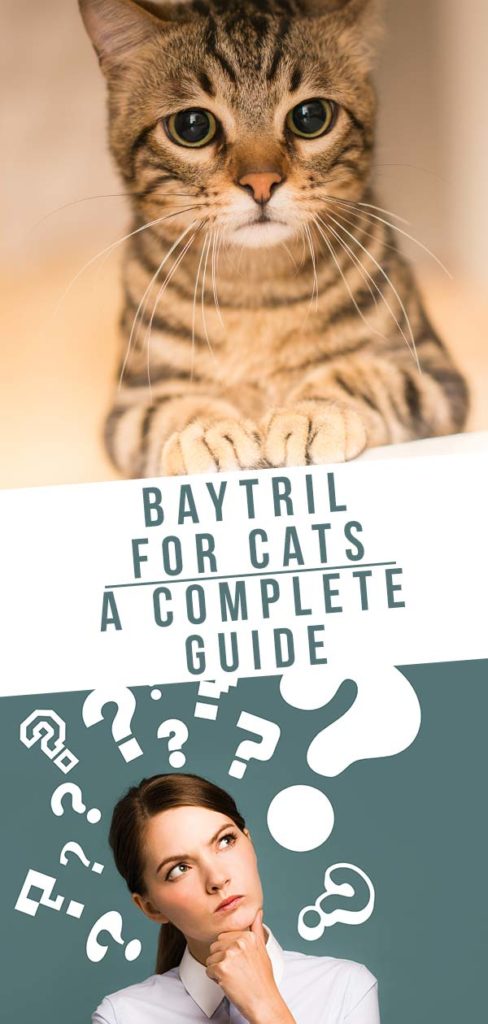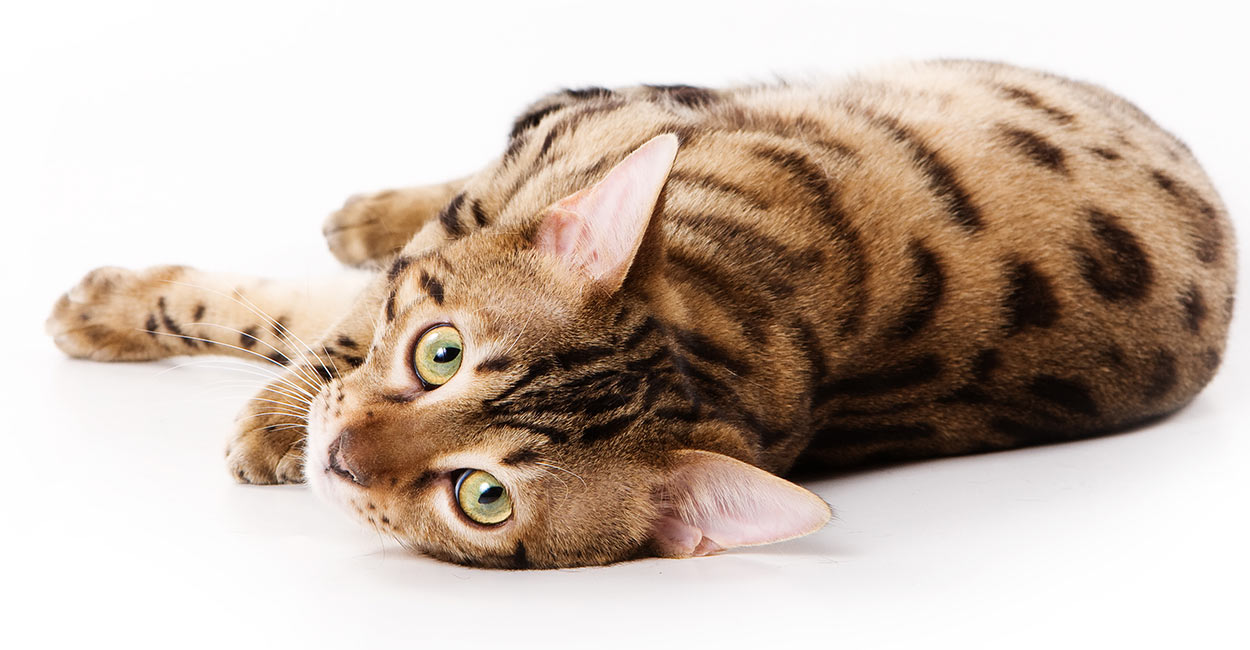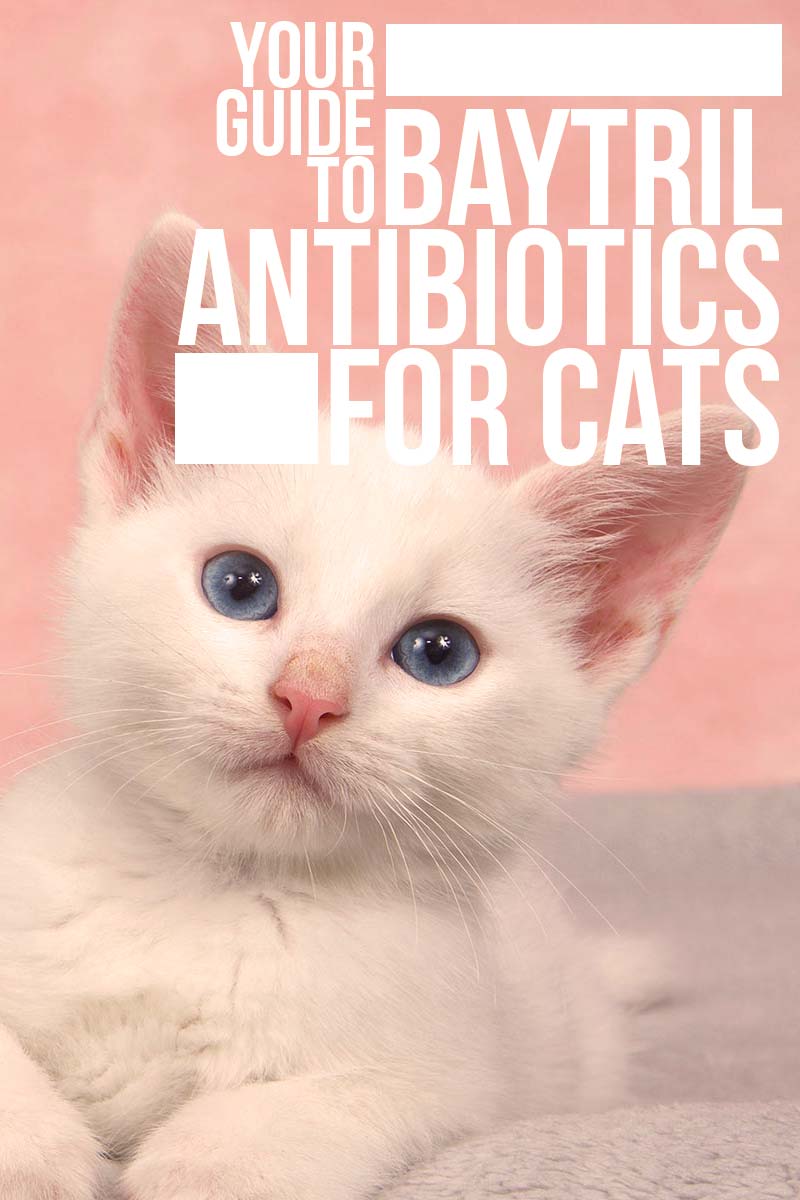
Baytril for cats is also known as Enrofloxacin. It is a synthetic broad-spectrum antibiotic, prescribed to fight infections in wounds, abscesses, and even urinary, digestive, ear and respiratory infections too. It’s usually a tablet but can come in injection form as well. Baytril is commonly given in tablet form, but can come in injections too.
Contents
- What is Baytril for cats?
- How does it work and what does it do?
- How to give your cat Baytril
- What dose does my cat need?
- What side effects are there?
- Which cats should avoid Baytril?
What Is Baytril For Cats?
Baytril is a brand name for Enrofloxacin, a prescription-strength antibiotic. It’s most often used for skin and ear infections, but can also be effective in the treatment of internal infections such as urinary tract infections (UTIs) and respiratory infections.
Baytril is a “broad spectrum” antibiotic, which means it’s effective against both Gram-positive and Gram-negative bacteria. That essentially means that it can be used to treat a wide variety of infections, because the drug is effective against most bacteria. It is fast acting as well as effective, so it is recommended by vets.
Baytril is approved for oral or otic use when given at home, though in some cases a veterinarian can give an injection.

How Do Antibiotics For Cats Work?
A bacterial infection in your pet can be a scary experience. Various types of infections are quite common, and can cause serious discomfort for your cat.
If treated properly, bacterial infections pose a minimal threat for serious damage – but it’s vital to treat these conditions as soon as possible. Fortunately, bacterial infections are not unusual. So there are many potential treatments at our disposal. Antibiotics for cats fight against bacterial infections. They can work in one of two ways.
- Bacteriostatic antibiotics stop bacteria from reproducing.
- Bactericidal antibiotics kill existing bacteria.
Baytril is of the second type. It kills existing bacteria, rather than just stop it from reproducing.
What Is Baytril Used For In Cats?
Baytril is a product of Bayer AG, a German pharmaceutical company that is one of the top 10 largest biotech firms in the world. Enrofloxacin, the active ingredient, was first synthesized by Bayer researchers Peterson and Grohe in 1980. It was released in 1988.
Since that time, Baytril has quickly become one of the most important treatments against bacterial infections in animals. It has no human applications. It’s active ingredient, Enrofloxacin, is a potent antibiotic that treats bacterial infections.

What Does Baytril Do?
Baytril for cats disrupts bacteria’s ability to make DNA, thereby killing the bacteria and preventing its spread. It is fast-acting and quickly penetrates all feline body tissues and bodily fluids. The rapid spread makes its use very common.
Baytril For Abscesses And Wounds In Cats
This antibiotic treats infected abscesses and wounds. The medication typically starts working within one or two hours of the first dosage, but it may take several days to be visually apparent.
It has shown the most clinical efficacy in treating wounds susceptible to infection by Staphylococcus aureus, Staphylococcus epidermidis, and Pasteurella multocida bacterial strains.
Baytril has a therapeutic effect in most tissues of the body. It is commonly used for more difficult-to-treat issues. Soft tissue infections, for example, require long-term antibiotic use. Typically, the antibiotic is prescribed for at least two or three days after the signs of infection disappear.
Baytril For Other Types Of Infections In Cats
Baytril treats urinary, digestive, ear, sinus, and respiratory infections. Pneumonia and other similar issues require antibiotics for a longer time. It is a common choice for health problems like these.
As with wound and skin infections, treatment will likely be prescribed for a short-term course. But in difficult or very serious situations, the course of antibiotics may run up to thirty days.
How To Give Baytril To Cats
Baytril for cats is a prescription-only drug. You can only obtain a prescription through a licensed veterinarian. This medication is common in coated tablet form. The coating helps to mask the bitter taste of the pill, so the medicine should not be crushed.
Liquid Baytril Otic for cats is applied topically in the ear. Baytril injectables for cats is also used in some situations, but not for home use. The injectable form of the drug is generally only available for use directly by a veterinarian or hospice care aid.
Additionally, an injection may have an increased risk of side effects compared to tablet forms.
Can You Give Baytril With Food?
Baytril for cats is most effective when given on an empty stomach. The coating of the tablet should help to ward against an upset tummy.
However, if your cat does have a stomach upset after taking the pill, such as nausea or vomiting, subsequent treatments can be given with a small amount of food or a treat. Do not use food that includes dairy.

Baytril Dosages
Your vet will prescribe the proper dosage amount for your pet. It will be based on the animal’s size, weight, and the condition needing treatment. The dosage may differ depending on the type of infection, as will the form of medication prescribed. For internal infections, Baytril tablets are common, while for ear infections you may be given Baytril Otic, a liquid drop form.
In tablet form, it typically comes in 22.7 mg and 68.0 mg sizes. In some cases, your vet may recommend splitting the tablets to customize the dose to your cat’s weight.
The Baytril injectable dosage for cats will differ from the tablet dosage. But this option is rare, and only performed by a vet. So there’s no need to worry about the injectable dosage.
The dose for cats should not exceed 5 mg/kg of body weight per day in cats in order to reduce the risk of retinal toxicity.
Baytril for Cats Treatment Protocol
Your vet will establish the treatment protocol for your cat during your visit. The health of your pet also plays a part. You should follow your vet’s recommendations closely. If something doesn’t seem right, follow up with your vet. But do not alter the treatment protocol without first consulting a licensed veterinarian.
Are There Any Side Effects?
Enrofloxacin is a highly effective, fast-acting treatment. Unfortunately, very few medications pose no risk of side effects. And broad-spectrum antibiotics like Baytril can also be toxic to the host organism, creating a higher potential for side effects. Some common side effects can include:
- Loss of appetite
- Vomiting
- Diarrhea
- Lethargy
- Convulsions
- Seizures (mostly in pets with central nervous system disorders)
- Cataracts (if used long-term)
In rare cases, Baytril may also lead to blindness in cats – particularly when used in doses exceeding 5mg/kg of bodyweight per day. Report side effects to your veterinarian if they become severe. Mild vomiting is common, but if you notice any more worrying side effects, be sure to give your vet a call.
Is Baytril Safe For Cats?
All these side effects, warnings and contraindications are enough to make anyone feel nervous about using Baytril for cats. However, remember that very few pharmaceuticals are completely without risks or side effects.
When your vet prescribes Baytril, they have balanced the potential for improving your cat’s symptoms against the unpleasantness of those side effects. In the hope that, in the end, the side effects will be worth enduring!

Using Baytril For Cats Safely
To reduce the risk of complications, be sure to:
- Fully describe to your vet all the medications your cat is taking
- Provide a full health history to your vet, including kidney issues, central nervous system disorders, and pregnancy
- Discuss all the treatment options with your vet to determine if Baytril is the right choice
- Do not exceed the recommended maximum dosage your vet prescribes
- Do not alter the treatment regimen without consulting with your vet first
- If your pet experiences side effects, report them to your veterinarian
In some cases, if your cat reacts poorly to the initial dose, the veterinarian may recommend a lower dose that can be gradually increased.
And there are, in fact, some cats that should not be treated with Baytril at all.
Cats Who Should Not Have Baytril
Baytril is not safe for use in pregnant cats, as the drug can cross into the placenta and potentially have a detrimental effect on fetal development.
It isn’t yet known if Baytril is safe for nursing mothers, as the drug can cross into the milk supply. Cats who are hypersensitive to quinolones should not have Baytril.
Discuss with your vet any reactions your pet has had in the past to prescribed or over-the-counter medications. Interactions with other drugs are also possible. Be sure to provide your vet with a detailed list of any medications your pet is taking to avoid interactions.
Cats with pre-existing kidney failure are particularly susceptible to Baytril side effects.
Can Kittens Have Baytril For Cats?
Baytril can interfere with kittens’ proper development. Enrofloxacin has a detrimental effect on growing bones and joints in young kittens.
Baytril For Cats Overdose
If you miss a dose, give the missed dose as soon as possible. If it’s close to the scheduled time for the next dose, however, you can skip the missed dose altogether. Do not give two doses at once.
In case of an overdose, notify your vet immediately. Monitor your cat for adverse reactions, such as dilated pupils or any apparent change in vision.
Treating Your Cat
If used in the proper dosages, Baytril is a relatively safe antibiotic drug for felines. It is a prescription drug. It’s vital to discuss your pet’s health history and treatment options with your vet, and to trust the veterinarian’s recommendations.
There are potential side effects. And pregnant or nursing cats as well as kittens should not be given Baytril.
Have you given your cat Baytril? We’d love to hear about your experiences with Baytril for cats in the comments section below.
References and Further Reading
- Forney, B, VMD. 2019. Enrofloxacin For Veterinary Use. Wedgewood Pharmacy
- Bayer. 2014. Baytril Product Label
- Lappin et al. 2017. Antimicrobial use Guidelines for Treatment of Respiratory Tract Disease in Dogs and Cats. Journal of Veterinary Internal Medicine
- Gelatt et al. 2001. Enrofloxacin-associated retinal degeneration in cats. Veterinary Ophthalmology
- Studdert VP , Hughes KL. 1992. Treatment of opportunistic mycobacterial infections with enrofloxacin in cats
My then 2 year old kitty was Rx. Baytril for a urinary tract infection. I was reluctant at first to give my kitty this medicine due to the side effects he could have. At the time he was going from one infection to the next and one antibiotic to the next. I really had no other recourse but to try it and my veterinarian assured me that it is a very effective medicine. My veterinarian gave him the injection and kitty did not have any side effect from it, thank goodness.
Hi. I have a appr.8 week old kitten. When I found him he had both back legs fractured and a toe infection. My vet pinned both legs and removed 2 toes. It’s been about 3 weeks. I brought him home for a few days. He began to use his legs and walk around. He had Torbutal and metacam. Within 3 days I had to rush him back to the doctor. He had given him batril for bone infection. Now his joints are so swollen and painful he can’t walk. Please answer as soon as possible. He wants to put him to sleep.
Baytril expire,can o still use it?
My cat, Maisy, is currently on Baytril Otic for a bacterial infection that is in her ears. It is working great so far – as she started acting more herself after a few days of use! I have noticed her lose of appetite but no other side effects!
Second antibiotic for bladder infection.
Having to ise 1/2 pill for dosing cat twice a day.
Because the barrier coating is missing, it causes immediate heavy frothing and fighting against the medication. An absolute horror to administer to my cat who has not reacted this adversely to any other medication.
Please make a half pill formulation so ot can be completely coated!
My 6 yr old female tabby has had repeat bouts of UTI, and when cultured, has been found to be e-coli. Finally got Baytril and it cleared up with no apparent side effects. She will not take any pills by mouth- vise grip jaw. I got the flavored tabs, but she doesn’t like them, and only tolerated taking it in a pill pocket a couple times. So I now crush it into her canned food, and make sure she finishes the food, twice a day.
However the infection returned after a couple of months. I’m hoping Baytril will continue to work, since I’ve spent a lot of money and gotten very frustrated with vets who seem totally baffled by recurring UTI and what they have in common is they are dedicated to selling prescription food.
We have a house feral that we trapped and took to the Vet because she was pooping in the house. After tests it was determined she has a very bad UTI and had to be shaved back there. There was also something on her left lung that the Vet didn’t like. It could just be her weight pushing on the lung. We were given Baytril pills to give her twice a day. The 1st thing I did was smash the pill up and put it in wet food with broth. She would not touch it. I then tried to cut it in half and put it in pill pockets. She would eat the pill pocket and spit out the pill. I tried putting it down her throat and she puked it up. She is repulsed by the smell or bitter taste or something. I called the Vet and they gave me needles to give her shots instead. My husband and I had to look up youtube videos on where to put the shot. I held her and my husband gave her the shot. She was in tremendous pain and kept shaking her leg and wouldn’t use it for a while. We were terrified we damaged her. We then tried me holding her and my husband trying to put the pill down her throat. She almost bit my husband and ran away and then spit the pill out. I don’t know what else to do but give up and hope she is ok. Her infection is doing great but I’m concerned with her lung. Any suggestions on what else I can try or what else I can do? This is very stressful for all involved. Thank you in advance.
tsamor This is how I give the meds in pill form to my cat. I place the pill in a small bowl, put a small drop of water on it, just enough to soften the pill. When the pill turns to liquid, I take a syringe (without the needle, of course), and place all of the liquid in it. Just slightly open cat’s mouth and squirt the syringe in. I have no problem this way and the cat gets all of her meds. You can purchase the syringes at the pet store or on ebay. They are very cheap.I hope this works for you.
The only way i can give baytril to my cat is with temptations. First i cut the 1/2 baytril into about 8 pieces. Yes they will be very small. Then i cut temptations in half, i empty the stuffing in the middle then i put 1-2 pieces of the pill and cover the pill with more of the temptations stuffing. So i give my cat about 8 halfs of temptations with hidden pieces of baytril in it. Tuna flavored temptations worked best.
Best way to administer Baytril to a problem cat is to buy a pill dispenser online from amazon. Get the small ones that have a tapered thin nazzle. It is possible to coax the cat to open for a fraction of a second and push in pill gun and push plunger. The tablet must be crushed into powder or the small chunks will clog the pill dispenser. The larger pill dispensers that hold the entire tablet are too wide , the cat will swat it away and the pills are not firmly held anyway. Works fine with practice. SD
Do NOT let your vet give this to your cat. My Yellow Tabbie, 14 lbs. 5 years old was given a shot and tabs for small infection…..After 3 days of treatment, he did not act right and we took him off of it. He is now partially blind. Has a hard time seeing up close unless all the lights are on. He has depth precetion problem now. Has problem judging objects near or far.
I very unhappy with this vet and thiis drug. There are other alternatives without blindness side effect!
My 16 yr old cat has been on 1/2 tablet daily for a week and starting the final week. She had a bladder infection and clavomox made her ill, so this was the next option prescribed. She takes it well – smashed up in her wet food – and I haven’t noticed any side effects, just more comfort and purring. Her attitude indicates she’s feeling better. Thankful.
Is there any reason why this drug might be administered for a cat with Cholangitis? It says to use caution when giving to a cat with liver disease and no other infections are present that we know of, just inflammation of the gall bladder and bile ducts. She’s supposed to be on this medication for a whole MONTH which has me extremely concerned about the potential for the blindness side effect.
Wound between shoulder of my cat for injecting her with baytril. Why this happened to my cat?Is baytril intramuscular only?